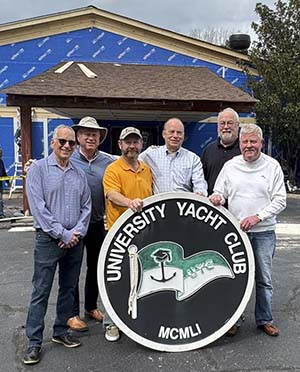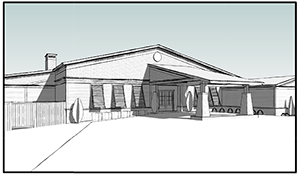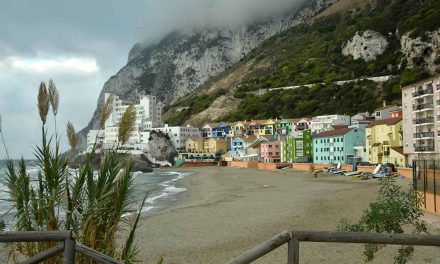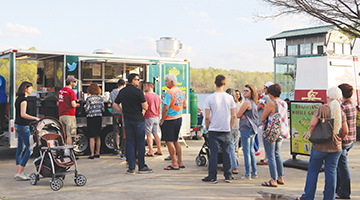
Members of the leadership and project team: (L to R) club member and general contractor Jack Wolfe; current Commodore Butch Miller; Facility Committee Chair Chris Clark; 2023 Commodore BB Benninghoff; club member and architect Sam Boyd; and 2024 Commodore Steve Simpson.
What began three years ago on a sub-freezing Christmas Eve has turned into a blessing in disguise for members of University Yacht Club. Last month, the club celebrated the beginning of a major remodeling of the clubhouse, the brick-and-mortar heartbeat of the historic club on Lake Lanier.
“Our clubhouse has always been the major gathering place since the early days of the club,” said Caleb Clarke, former commodore and current fleet chaplain. “It has been through many changes, including a change of location on our property, but for our UYC family it holds many memories.”
Three years ago, the journey began that brought the club to the good news celebrated in March.
On December 24, 2022, temperatures dropped to a low of 9 degrees and throughout the day never rose higher than 27 degrees. As a result, pipes in the UYC Clubhouse burst from the freeze, leaving behind a flooded dining room and causing the club to be closed for several months.
The club’s board was quick to act, shifting holiday events to other locations on the 20-acre campus, bringing in insurance adjusters and eventually contractors to restore the interior.
Within a couple of months, members witnessed a transformation of the interior to modern décor, the installation of baffles for less room noise and new carpet and millwork.
But that’s just the start of the most recent history of the clubhouse at University Yacht Club.
Looking back
Lake Lanier was still under construction when University Yacht Club was chartered in 1951. It would take another five years before the organization purchased a peninsula on Lake Lanier at the end of Big Creek where the club still operates.
Clarke shared the story of the clubhouse from those early days.
“Our first clubhouse was an A-frame on the point of the peninsula that had two levels,” he said. “The main floor was the family space and the ‘crow’s nest’ was a hangout for adults only.
“Once member happy hour was over, they’d come back downstairs to have a family dinner.”
The A-frame included a very small kitchen and meals consisted of foods that came straight out of the freezer or refrigerator. “It was very simple, like hot dogs, hamburgers and quick eats. At that time the club was certainly not known for its cuisine like it is now.”
The club carried on with its A-frame clubhouse as it grew to nearly 200 members. But in the early morning hours of February 27, 1977, a fire broke out and the A-frame burned to the ground. The club’s published history related that the fire was likely caused by leaking LP gas that may have been ignited by the stove pilot light.
The board faced several major decisions: where to locate the replacement clubhouse and what type of facility to build.
“The first clubhouse was built on Corps of Engineers’ public lands, so the new club would be built solely on land leased from the Corps to the club. The A-frame was used during the warmer months, when the social and boating seasons were at their peak, so many wanted to have a facility that could be used year-round.”
Funding could have been a problem for building an improved and upgraded clubhouse, but the board voted to use the insurance funds and to sell some of the club’s property to raise the capital.
“This club has never held a mortgage,” Clarke said. “The ‘new’ clubhouse was built by July 1978 and consisted of a large room that could be divided, a wrap-around porch and sliding glass windows for stunning views of the lake. A small kitchen was included to provide simple meals.”
Soon it became apparent that more space and additional capabilities would be needed. The club was growing, developing a more active entertainment and social calendar.
“By the early 1980s, it was time for some adjustments and expansion to occur,” Clarke said. The first of several renovations increased the seating capacity of the dining room and built a kitchen and food service area to accommodate more elaborate meals.”
At that time, the club served meals six of seven days a week, but in recent years its restaurant is open three days a week, with chef-curated cuisine for breakfast, brunches, lunches and dinners.
As the years progressed, the clubhouse underwent other physical improvements, such as enclosing a large veranda, further improving the kitchen and significantly changing the décor.
Finding the silver lining
BB Benninghoff was commodore when the Christmas Eve freeze/flood occurred and the clubhouse was closed for several months. What began as repairs soon became a larger project.
“When the contractors began repairing the damage, they discovered a great deal of moisture , rotten wood and deterioration in the interior walls,” Clarke said. “Although the restoration was complete, the board realized that it was only a temporary solution.”
Discussions continued about the physical state of the clubhouse and both Bennington and his successor Steve Simpson, along with the board examined many options.
The result? The board voted to remodel the clubhouse, making improvements to both the exterior and the interior. Another set of restrooms is being added and a second veranda add more social and gathering area.
 Architect Sam Boyd designed the project and Jack Wolfe is serving as general contractor. As chairman of the facilities committee, Chris Clark and his committee are involved, representing the club’s interest as construction progresses.
Architect Sam Boyd designed the project and Jack Wolfe is serving as general contractor. As chairman of the facilities committee, Chris Clark and his committee are involved, representing the club’s interest as construction progresses.
Construction began in early March and the work is projected to be completed by early summer.
“The remodeling began with BB’s term as commodore when the dining room was restored and significantly improved,” said current Commodore Butch Miller. “BB and his successor Commodore Steve Simpson and the board led the decision to undertake the remodel. Both of them have shared their visions of the next phase of the life of University Yacht Club and our members are enthusiastic.
“This is probably the most significant initiative we’ve undertaken in several decades,” said Miller. “Our club members are very excited about what’s happening and how the project is coming along.
“We’ve planned a big celebration when the work is finished,” he said. “UYC is entering a new phase and there’s a noticeable increase in our members’ involvement and pride.”
Clarke concurs. “Our future is bright, our membership is increasing and our UYC family is continuing to grow,” Clarke said. “We’re in a great place, and in some ways that Christmas Eve freeze and flood has turned into a silver lining.”
Aerial Club House photo: by Larry Griffeth; UYC leadership and project team Photo: by Pamela A. Keene; clubhouse image: courtesy UYC







